How FilterPixel Shortens Your Workflow By 80% Through AI - FiterPixel
By Aayush Arora
My journey with photography began one afternoon after completing my entrepreneurship course at MIT in Boston, where I, along with my professor stumbled upon a unique connection – a shared passion for the intricate strategies of chess.
As we engaged in a captivating chess match, a young photographer captured the essence of the moment through the lens of his DSLR. Although the game was exhilarating, what truly intrigued us was the photographer’s response when I asked for the photos:
“It’ll take three weeks.”
Intrigued by this seemingly excessive timeframe, we delved deeper, discovering that only 20% of a photographer’s time was spent capturing photos, while a staggering 80% was consumed by the arduous process of selection and editing. This revelation led us to explore the world of professional photography.
Chapter 1 Introduction: How AI is Transforming Photography Workflows
In today’s fast-paced world of photography, staying ahead of the curve is more essential than ever. Whether you’re a professional photographer striving to streamline your processes or an enthusiast looking to take your shots to the next level, the role of artificial intelligence in reshaping photography workflows is undeniable.
 Image by Microsoft Bing
Image by Microsoft BingAs in any other industry, having a fast, efficient workflow is the gold standard. For professional photographers, this means way less hours spent glued to your computer, importing, culling, and editing thousands of images.
It also means you will have more time to focus on getting creative at shoots, booking new clients, and managing the day to day operations of your business.
It’s a win-win situation for you and your clients.
Likewise, hobbyists can equally benefit from these features as it ultimately provides you with more time to enjoy taking photographs, sharpen your skills behind the lens, and ensure consistent editing results for batch processing.
All you really need to do is to embrace the transformative power of AI and take advantage of its capabilities.
Enter FilterPixel – a game-changing solution that is set to transform the way you organize and post-process your images by harnessing the power of AI.
 FilterPixel App Homepage
FilterPixel App HomepageFrom the fundamental stages of importing and sorting photos to the more technical areas of culling and editing, FilterPixel provides you with a smarter and easier way to go through all of these phases in producing top-quality images.
Its remarkable ability to shorten the culling process by 80% and its highly customizable controls empower photographers of all levels of expertise to streamline their processes while maintaining total creative reign over their images.
In this article, we will delve into how FilterPixel is revolutionizing the way photographers work and how you can leverage this technology to make your entire process more efficient while boosting your creativity.
Chapter 2 Importing and Sorting Photos: Why It’s Important and How to Simplify The Process
The first step of every photographer’s post-production process is importing and sorting images.
 Image by George Milton (Pexels)
Image by George Milton (Pexels)When you’re working on consecutive shoots, categorizing the photos from each session becomes an obstacle. This stage alone is already incredibly time consuming, labor-intensive, and prone to human error.
Among the most common challenges photographers face when it comes to importing and sorting photos are:
- Time Drain – Sifting through thousands of photos manually can take you hours, or even days. The time you spend on this process could have been better allocated on more valuable, creative tasks.
- Higher Risks of Oversight – In going through images one by one, you’re bound to miss good shots or mistakenly discard a valuable image because of fatigue or simple oversight. Even the most coveted professional photographers still encounter the same experience.
- Increases Chances of Burnout – Renaming files, creating new folders, and categorizing images for hours at a time can be monotonous. These repetitive tasks easily exhaust the mental energy of photographers, making them dread this part of the process even more.
However, the way you execute your image importing and sorting sets the stage for a seamless post-production process.
It’s essential for every photographer to have an organized photo library for a few key reasons:
- Easy Access and Retrieval of Images – Locating and identifying specific shots from a gallery that contains thousands of images can be immensely time-consuming and frustrating. With a properly systemized photo library, you can conveniently pull out the files you need, saving hours in sifting through a cluttered digital pile.
- Improves Workflow – When your photos are organized and cataloged, you can seamlessly progress from one post-production stage to the next. It will help you save a lot of time and resources, while reducing the risk of errors and inconsistencies.
- Boosts Creativity – Photographers often get preoccupied with the thought of their growing post-production pile which becomes a huge distraction and limiting factor during shoots. With a structured importing and sorting process in place, you will have more time and energy to focus on the creative aspects of photography in order to deliver high quality work.
These reasons and risks only prove how fundamental strategically sorting images is, and how every photographer must learn to excel in this process if they want to become recognized professionally.
However, this is easier said than done. We understand that importing and sorting images is also one of the biggest challenges among professional and hobby photographers. Fortunately, today’s technologies equip us with the opportunity to improve and simplify the otherwise tedious process.
Streamlining the Importing and Sorting Processes Through AI-Driven Photography Tools
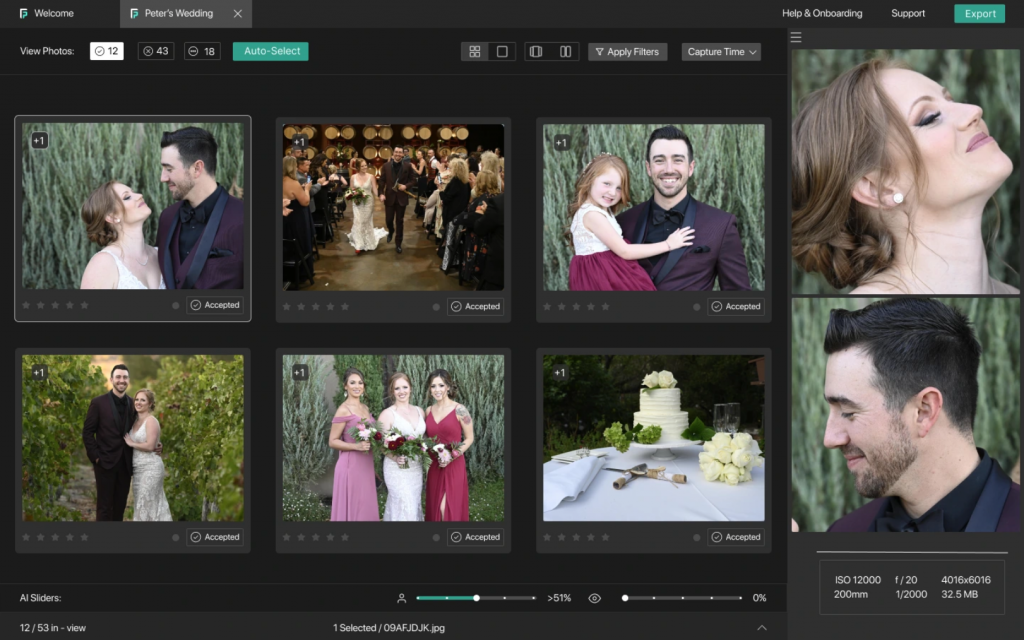 FilterPixel Culling Interface
FilterPixel Culling InterfaceApart from the time-saving aspect that AI brings to the table in terms of photo importing and sorting, advanced AI-driven tools such as FilterPixel provide more extensive advantages, simplifying the entire post-production process and improving your workflow.
- Smart Organization – FilterPixel analyzes and categorizes photos based on a set criteria, such as date, location, subject, matter, and quantity. This intelligent and automated segmentation will help you keep your image library organized and cataloged without having to manually sort through terabytes of content. Likewise, it makes searching for photos quick and easy.
- Customizable Criteria and Preferences – Every photographer has their own specific styles, needs, and preferences particularly when it comes to how they sort and organize their files. Through this AI-powered tool, you can set your own criteria in terms of levels of priority, focus, and other filters that will enable you to do your job better. This level of customization also ensures that FilterPixel aligns with your creative vision and direction.
- Instant Previews – Not all AI-driven photography tools offer this unique feature. FilterPixel provides quick previews of images imported from your storage device, which makes it easier to identify workable shots for editing and detect any possible issues in the photo set. In such cases, you will be able to immediately think of solutions to address concerns with the images.
- Filtering Duplicates – Duplicate images merely serve as clutter in your photo libraries that take up a significant amount of storage space. This is another reason for having an AI-powered software such as FilterPixel, which automatically groups similar photos and selects the best version in each group of duplicates.
Evidently, AI-driven photography tools such as FilterPixel eliminates the pain of importing and sorting images. It frees up your time and mental energy, allowing you to explore the creative aspects of photography more than ever. It cuts the monotonous phase of post-production, making it easier for you to proceed with editing and delivering top quality images for either your personal or professional use.
In order for you to leverage FilterPixel and its extensive features, let us first delve into the culling process and the role AI plays in elevating the rest of your post-production workflow.
Chapter 3 Understanding Photo Culling
It’s every photographer’s goal to have perfectly crafted images– every shot flawlessly composed and in focus, with the light hitting the subjects immaculately. But every professional and hobby photographer also knows that this is not feasible.

Image by Faruk Tokluoğlu (Pexels)
After every photo session, there will be shots that won’t meet your expectations and your clients requirements or standards. This is where photo culling comes into play.
What is photo culling?
FIlterPixel Video – What is Photo Culling
Photo culling is considered as one of the most essential skills any good photographer needs to possess– and for good reason. Culling is the process of filtering through image sets and curating the best ones that meet a specific criteria. The primary goal of this phase is to identify and retain the highest quality images while discarding the rest. It is an important step in the post-production process that impacts:
- The quality of your work – Through photo culling, you can ensure that only the best versions of your shots will make it to the final collection, consistent with your portfolio.
- The efficiency of your workflow – Whether you’re into photography as a hobby or a career, being able to reduce the time you spend locked down with your editing software is a welcome benefit. Automated photo culling streamlines your post-production workflow so you can skip the mundane labor of managing a large quantity of photos.
- Your clients’ satisfaction – For professional photographers, culling ensures that you deliver a curated set of images that will meet or exceed your clients’ expectations. Likewise, it guarantees better consistency in the quality of your finished products. With great feedback also comes loyal customers and the opportunity to attract more potential clientele.
However, photo culling is also one of the most grueling phases of photography for a variety of reasons. The most common challenges photographers encounter in the culling process are:
- Taking too much time reviewing a high volume of images – In a single shoot, any photographer can come up with thousands of images to ensure that they cover all bases. Understandably, photo sessions, particularly those of once-in-a-lifetime events, staged sets, and commercial shoots do not get a rerun. However, this results in a huge number of photos. Manually reviewing and filtering each image can take days or weeks. For photographers with tight deadlines and those in-demand with back to back shoots, the time spent culling images could have been better allocated to other important tasks such as editing or client meetings.
- Photo culling is highly subjective – While you can assign someone else to cull images, there’s no guarantee that you will achieve the results that you want for a specific photo set. What you may consider a good take might not be the opinion of another photographer or your assistant delegated to handle culling. This subjectivity makes it more challenging to maintain a consistent style or quality across your portfolio. Likewise, this also leads to higher risks of mistakenly discarding potentially valuable shots. In a rush to cull images quickly plus the varying perspectives of everyone looking at your raw shots, it’s easy to overlook photos that may only require minor edits to transform into remarkable images.
- Causes workflow bottlenecks – Culling often becomes a major bottleneck in a photographer’s workflow, causing the whole post-production process to slow down. Because it is the middle ground between the shoot and the editing phase, any hold up in the culling stage will lead to delays in delivering the final products.
- It’s a mundane, repetitive task – Both professional photographers and hobbyists eventually find culling to be monotonous, especially if you need to go through a high volume of images and have regular photo sessions. At one point, your files start to pile up, which means that you’ll need to block hours in a day just to manually go through every one of them. It then becomes a repetitive, stressful process that may lead to burnout.
- New camera technologies – While technological advancements for your gear is always a great opportunity to create more notable photographs, it also means a bigger challenge in culling. As taking photos becomes easier through your latest camera with a plethora of automatic features, you are able to generate more images per shoot. This means a load more of shots that go into the culling stage, requiring more time and effort in filtering.
These are some of the primary challenges that AI in photography aims to solve. Beginning your post-processing with photo culling is the most ideal way to go, as you eliminate shots that you can’t use, maintain an organized filing system, and stay on top of your curated work. Likewise, it significantly cuts your editing time because you can seamlessly do batch edits with a filtered gallery.
It’s important to note, however, that for photo culling to be beneficial, you will need to do it efficiently and strategically with the use of an AI-driven photography tool. Doing so will enable you to:
- Reallocate saved time in taking on more projects, widening your client base, and accomplishing editing tasks
- Concentrate on the creative aspects of photography and be able to spend more time in shoots
- Develop consistency, avoid errors, and build a stronger portfolio composed only of the best versions of your photos
Traditional Photo Culling vs. AI-Powered Culling
 Image by Beyzanur K. (Pexels)
Image by Beyzanur K. (Pexels)Since the birth of digital photography both as a career and a hobby, people have traditionally relied on their own judgments and experiences to manually cull their photo libraries. This practice may have been enough in the earlier years, as it complemented the camera technologies available then. Bearing in mind today’s advancements and the accelerated growth of the photography industry in general, the limitations of manual photo culling are becoming more evident.
Now that photographers are able to take thousands of photos in every shoot, the entire traditional culling process has become much of a drag. It’s time-intensive, exhausting, and delivers inconsistent results.
Meanwhile, AI-driven photo culling offers the complete opposite. Considered as a game-changer in the photography industry, automated programs such as FilterPixel dramatically improves the entire culling process by shortening the time spent culling images by at least 80% and leveraging AI algorithms that make automated decisions based on your predefined criteria. As a result, AI-powered tools can churn out consistent and top quality images, rapidly and accurately.
Understandably, there are still some photography enthusiasts and professionals skeptic about utilizing AI in their post-production processes.
In order to break through these hesitations and have a better understanding of AI-powered photo culling, let’s delve deeper into the core technology of FilterPixel.
Chapter 4 FilterPixel’s AI-Powered Culling Algorithm
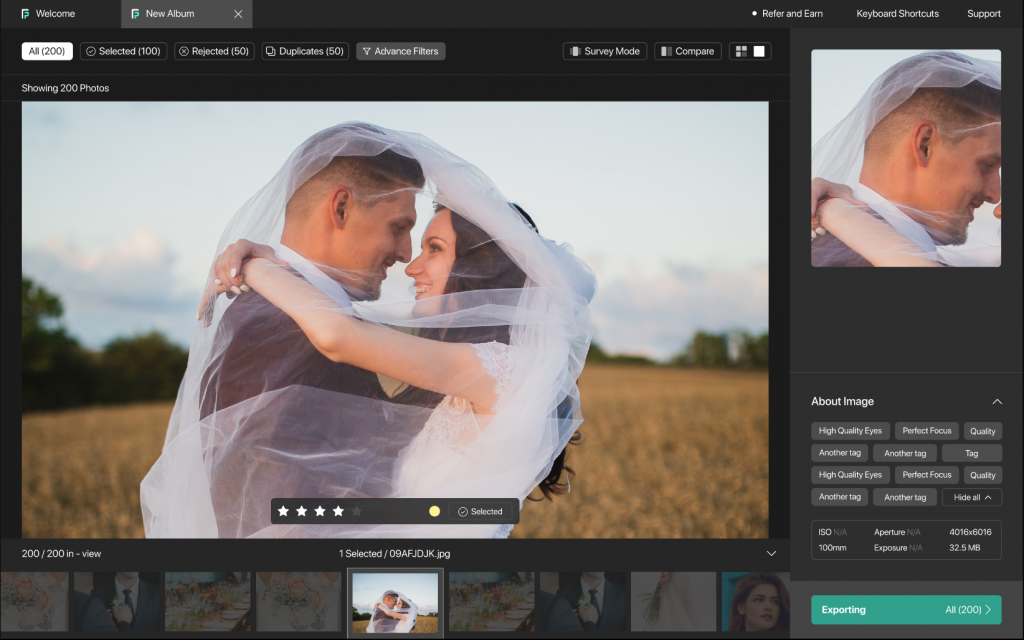 FilterPixel photo culling software dashboard
FilterPixel photo culling software dashboardOne of FilterPixel’s most transformative features is its cutting-edge AI-driven culling algorithm that aims to redefine the way photographers curate their collections efficiently and with remarkable precision. The software has been called a game-changer for both enthusiasts and professionals primarily because of its core technology– the integration of advanced machine learning and vision technologies comprised of:
- Neural Networks – A subset of artificial intelligence, neural networks are designed to mimic the human brain’s pattern recognition abilities. The networks ingrained in FilterPixel have been conscientiously fed vast datasets of images, which enables it to recognize patterns, objects, and quality attributes within any series of photos. This specific feature makes it possible for the software to filter through thousands of images and segregate them according to which are acceptable and those that can be disregarded based on the basic rules of photography.
- Image Recognition – One of the most valuable components of AI culling algorithms is being able to identify elements such as faces, subjects, compositions, and even subtle nuances like facial expressions and eye contact. The level of detail FilterPixel considers ensures that beyond the technical criteria, the artistic and emotional aspects of an image are given ample consideration.
- Predefined Criteria – To ensure your creative hand in culling images, FilterPixel allows photographers to customize the segregation criteria according to your specific preferences and vision. You won’t have to worry about being overturned by an algorithm that can’t recognize your unique style and creative direction.
- Continuous Learning – The beauty of AI is that it never remains static. As you continuously use and feed it with new images, the system learns and improves. In doing so, FilterPixel ensures that the culling process becomes even more accurate and attuned to your unique style and specific requirements.
Now, how exactly do these features impact your photo culling efficiency and overall workflow?
Benefits of FilterPixel’s AI-powered Culling Algorithm
Among its numerous benefits are:
- Increased speed in culling a large number of images in a fraction of the time it would take to do it manually, ultimately scaling your capacity to accomplish more work and take on bigger projects moving forward.
- Establishing your style consistently through an objective and reliable automated culling process that ensures each image meets your predefined criteria and standards.
- Mitigates the risks of oversights or errors as it can identify valuable shots 24/7.
- Accurately culling images so you can focus on more important areas to grow your business.
With these features in mind, you can now explore how to leverage the benefits of having a reliable software that is FilterPixel.
Chapter 5 How to Use FilterPixel: A Step-By-Step Guide
Now knowing the possibilities you can delve into with FilterPixel, we’ll walk you through the process of harnessing its AI-powered photo culling capabilities to streamline your photography workflow and improve your post-processing experience.
STEP 1: Sign Up and Install
Simply visit the FilterPixel website to create an account. Once your account has been verified, you can download and install the software on any PC or Mac device that you use for photo management.
STEP 2: Set Up Your Account
Log in to FilterPixel and accomplish the necessary steps to complete your account setup. This where you can set the software according to your preferences through the customization options.
STEP 3: Import Your Photos
You can easily connect your camera or storage device to the computer where FilterPixel is installed. Upon plugging in, it will automatically be detected by the software and initiate the import process. In just a couple of clicks, your images will be transferred to your photo management and editing device.
STEP 4: Customize Your Culling Criteria
This crucial step allows you to fully leverage the AI-powered photo culling capabilities of FilterPixel. To customize the software to adapt to your unique style and preferences, locate the Access Preferences option. From there, you can seamlessly adjust the parameters of your culling and refine the criteria to specify the quantity of photos you need to be filtered through.
STEP 5: Let the Culling Begin!
Once you have imported the images and customized your culling criteria, the culling process itself can commence. The AI will start by analyzing your photos based on the criteria you’ve initially defined. From there, you can:
- Review the system-initiated selections to ensure that they reflect your set preferences.
- Make adjustments as you deem necessary. In cases where you might find images that you believe should either be included or excluded, you can manually change FilterPixel’s choices. In doing so, its AI technology will also learn from your manual adjustments to improve its performance in your next photo culling sessions.
- Finalize the culling process once you’re satisfied with the results. FilterPixel will then save the chosen images while discarding the rest, to reduce the volume of photos you will need to manage as you start editing.
This 5-step process covers the fundamentals of setting up your FilterPixel account down to your first AI-powered photo culling experience. As convenient and intelligent the system already is, there’s more you might want to know in order to maximize your culling efficiency through AI’s vast capabilities.
Tips on Maximizing FilterPixel’s Photo Culling Efficiency
As we have established earlier, AI generally absorbs and adapts to your photo culling behaviors as it develops precision based on your unique style and preferences. Consider these tips to make the most of your software’s capabilities:
- Regularly review your set preferences – From time to time, it’s important to revisit the culling criteria you’ve set to ensure that they still align with your evolving requirements. Likewise, in your work as a photographer, different clients may have varying themes and preferences for their images that you may have to take into consideration. In such cases, you will need to review your initial setup and make the necessary adjustments each client or situation entails.
- Don’t be afraid to experiment and learn with it – Playing around with your software’s criteria and other settings will not only help you discover what works best for your photography style, but also fills AI’s knowledge bank in learning your distinct preferences. This way, FilterPixel will be able to cater more specifically to your needs and requirements, further streamlining your photo culling process.
- Stay involved and engaged – The common misconception with using AI technology is that photographers think they can just click and leave it alone to do its job. While such software will accomplish the basic culling tasks for you, it’s still important to constantly review AI’s selections before finalizing the filtered photo set. Your creative input remains valuable as AI can never replace your unique eye as a photographer.
By following these steps and advice, you can leverage the full potential of FilterPixel’s AI-driven photo culling technology. Doing these will enable you to have more time and energy for the creative and business sides of photography.
Chapter 6 Real-World Benefits: FilterPixel Case Studies and User Experiences
What does FilterPixel look like in practice?
In this chapter, we’ll provide you with some examples and case studies of photographers who have integrated FilterPixel into their workflows but showcasing their specific challenges and how this AI-driven software addressed their concerns.
Case Study 1: Portrait Photographer’s Time Efficiency
 Image by Celine (Pexels)
Image by Celine (Pexels)Sarah is an in-demand professional portrait photographer, constantly moving from one shoot to the next. Her packed schedule often results in thousands of digital images that she needs to sort through and post-process within a specific timeframe. This has caused a lot of unnecessary stress, that she had to reconsider the number of clients she should be taking, given the pile up at her importing and culling stages.
Before discovering FilterPixel, she had to manually sort and select her images, taking hours of her time that she could have spent accommodating more shoots. Upon implementing FilterPixel into her workflow, she noticed remarkable changes in the time she spent culling images, the quality of her edits, and the refined experience she’s able to deliver to her clients during photo sessions. The conveniences that FilterPixel provides has elevated her entire business by automating a crucial, and otherwise time-consuming step of the post-production process.
Case Study 2: Event Photographer’s Consistency
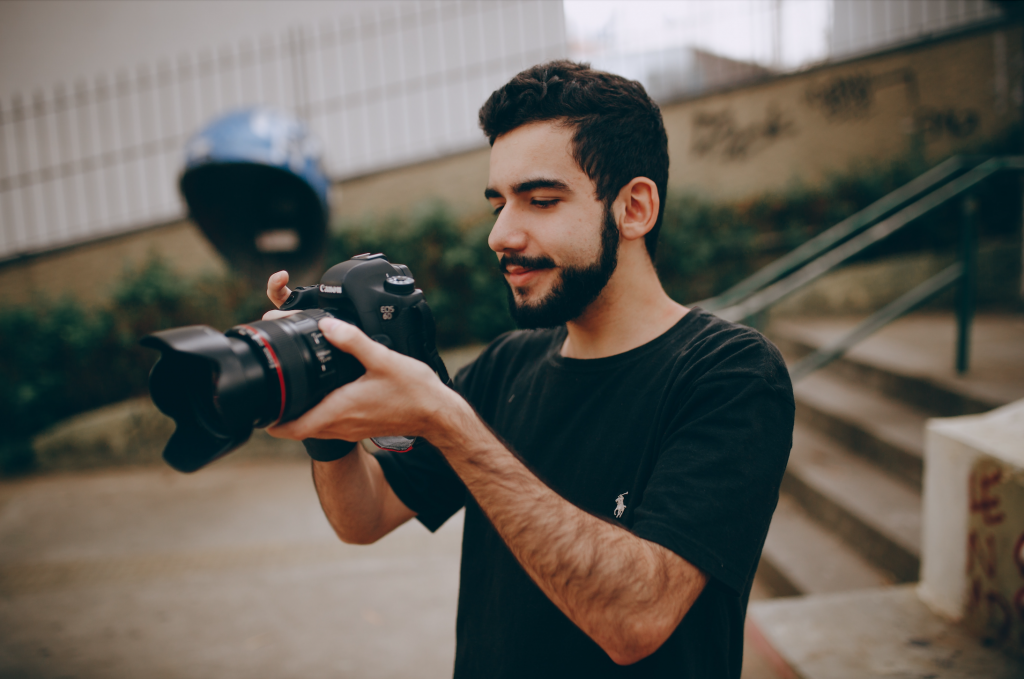 Image by Rafael Barros (Pexels)
Image by Rafael Barros (Pexels)Events are always quite challenging to shoot because of the many movements and external factors a photographer needs to consider in each shot. This is the case for John, a seasoned event photographer who specializes in weddings and corporate gatherings. His biggest challenge is maintaining consistency across diverse ranges of events, in order to deliver top quality images that reflect his personal photography style that his clients hired him for.
Traditional, manual photo culling methods led to inconsistencies as John is also influenced by external factors, making it difficult to meet each client’s expectations.
Through FilterPixel’s AI photo culling, John has been able to define consistent standards and criteria for selecting images from different events. The software enabled him to provide the same quality and style standards for each of his clients, who likewise have shown appreciation for the reliability of his work. Currently, John is enjoying an increased number of loyal clients and referrals, ultimately boosting his business.
“I am thrilled to share that not only has Filter Pixel been a game-changer in saving me valuable time and energy in my workflow, but the staff is also incredibly friendly and helpful. Their programs have been a true delight to work with, streamlining my workflow. The time and energy I’ve saved are truly remarkable. I couldn’t be happier with the experience so far!”
Kendra, Wedding Photographer
These case studies not only highlight the transformative impact of FilterPixel’s AI-powered culling technology, but also provides more insight into a typical photographer’s daily challenges. However, sorting images is just one of their major tasks they often need a hand on.
As you may already know, photo culling is just the second step of the post-production process. After which comes another tedious phase, which is editing. So, can AI also provide assistance in editing images? How can FilterPixel be utilized for the final stages of post-processing? We’ll answer these questions in the next chapter.
Chapter 7 Going Beyond Photo Culling: FilterPixel’s Image Editing Capabilities
While the software’s primary claim to fame is its exceptional AI-driven culling algorithm, it doesn’t stop there. FilterPixel sees the entire post-production process through with its editing features, fulfilling its promise of streamlining every photographer’s workflow. In this next section, we’ll talk about how this AI-powered tool can seamlessly transition you from culling to editing.
FilterPixel’s Unique Editing Features
Providing photographers with a one-stop solution for their post-production needs, FilterPixel has extended its capabilities from AI-powered photo culling to editing. With the software, you will have access to the following features:
- Image Enhancement – Easily adjust exposure, contrast, brightness, saturation, vibrance, and sharpness to achieve your desired image style and quality.
- Color Correction – Consistent color balance across each photo set is important in maintaining a cohesive style. FilterPixel’s color correction and grading tools allow you to apply your signature color treatment within the software itself.
- Batch Editing – A common practice among photographers, applying consistent edits to multiple photos from the same event, location, or set at the same time is an essential feature sought from any editing software. FilterPixel provides the same level of batch editing capabilities that you would typically find in other editing-only software.
- Workflow Integration – Most photographers are already using popular editing software, such as Adobe Lightroom. FilterPixel seamlessly integrates with your primary post-processing app so you can easily use your existing tools alongside this AI-powered culling and editing tool.
Whether you’re a professional photographer or an enthusiast, FilterPixel simplifies your workflow by providing a single platform for your post-production needs.
Utilizing FilterPixel for photo culling and editing allows you to go through the post-production process smoothly as you no longer need to switch between two separate softwares. Likewise, it ensures consistency and creative control as it provides a range of editing options and settings where you can express your unique style.
Chapter 8 FilterPixel for Different Photography Specializations
Photography is a diverse field with various specializations, each with its own set of needs and challenges. FilterPixel recognizes the importance of addressing the unique requirements of photographers catering to various niches. In this chapter, we’ll discuss how each type of photographer can leverage FilterPixel and its capabilities.
How Portrait Photographers Can Benefit from FilterPixel
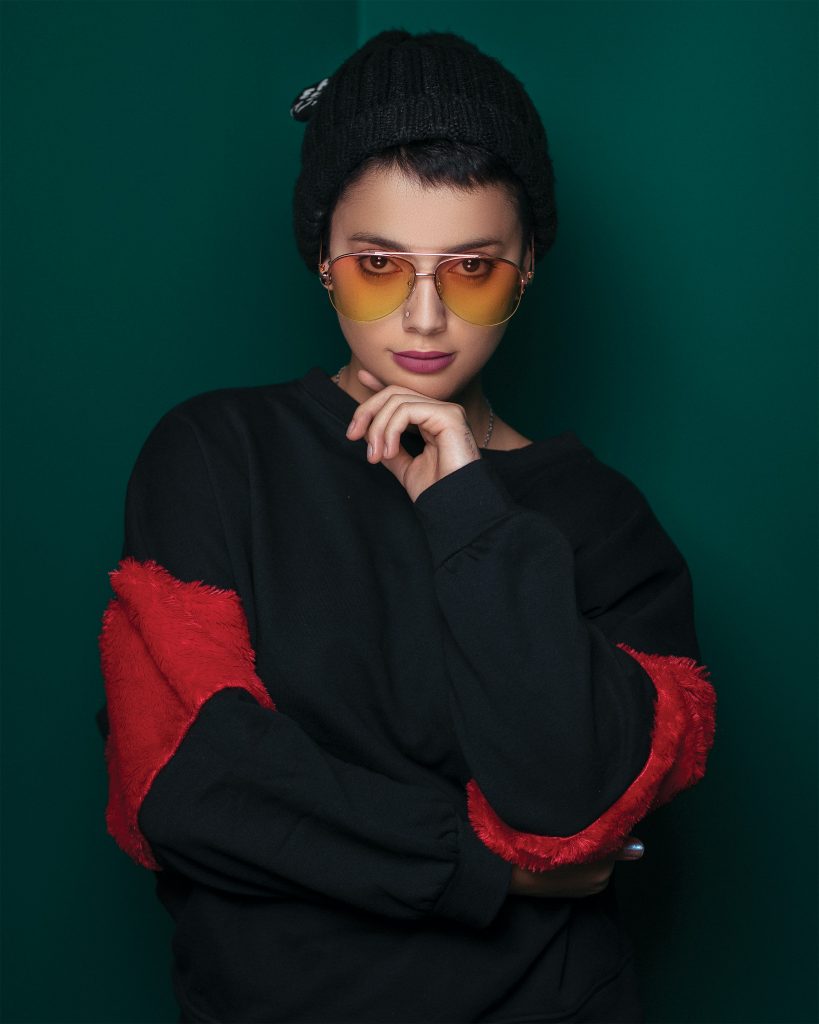
How Event and Wedding Photographers Can Benefit from FilterPixel
 Image by Becerra Govea Photo (Pexels)
Image by Becerra Govea Photo (Pexels)Event and wedding photography is all about capturing the picture-perfect moments while navigating dynamic settings. FilterPixel can enhance any event photographer’s workflow through:
- Accelerated photo culling and selecting the best shots among batches of images, even from extensive collections.
- Ensuring a consistency in the style and quality of images selected and edited– an essential requirement from event photographers.
- Promptly delivering post-processed images to meet tight deadlines.
How Landscape and Nature Photographers Can Benefit from FilterPixel

To capture breathtaking images, landscape and nature photographers require immense precision and extensive post-processing tools to highlight the beauty of natural landscapes in their images. FilterPixel helps these photographers achieve stunning photos by:
- Eliminating the hours spent on photo culling so they can focus more on perfecting the editing and compositions of images.
- Editing images in batches to ensure that each set of photos have consistent color grading tactics applied.
Other photography specializations such as food, fashion, or architecture photographers will also find FilterPixel’s AI-powered culling and editing capabilities useful. By customizing the software’s criteria and continuously learning alongside its core technology, you can benefit from the efficiency, consistency, and time savings it offers. As a result, it will enable you to produce top quality work that meets or even exceeds your clients’ and audiences’ standards.
Chapter 9 FilterPixel vs. Other Photo Culling & Editing Tools
As the photography industry is constantly growing and evolving, numerous culling and editing tools have been developed for both professional photographers and hobbyists. In this section, we’ll discuss how FilterPixel fares in comparison to other culling and editing software, particularly the most popular ones in the market today.
Among the commonly used photography tools that provide photo culling and editing are:
- Adobe Lightroom – Widely used because of its seamless integration with other Adobe programs, Lightroom offers only basic culling and editing features as it is meant to be integrated with the entire Adobe Suite which provides more extensive library management and image enhancement settings.
- Capture One – This tool is favored by many professionals because of its powerful culling and editing features, particularly in color grading and tethering.
- PhotoMechanic – This software is known for its rapid image previewing and sorting features, which is why it’s the top choice for most photojournalists and sports photographers.
- ACDSee Photo Studio – It provides both culling and editing features in one software similar to FilterPixel, however, it doesn’t offer specific automations for importing and sorting images.
What sets FilterPixel apart?
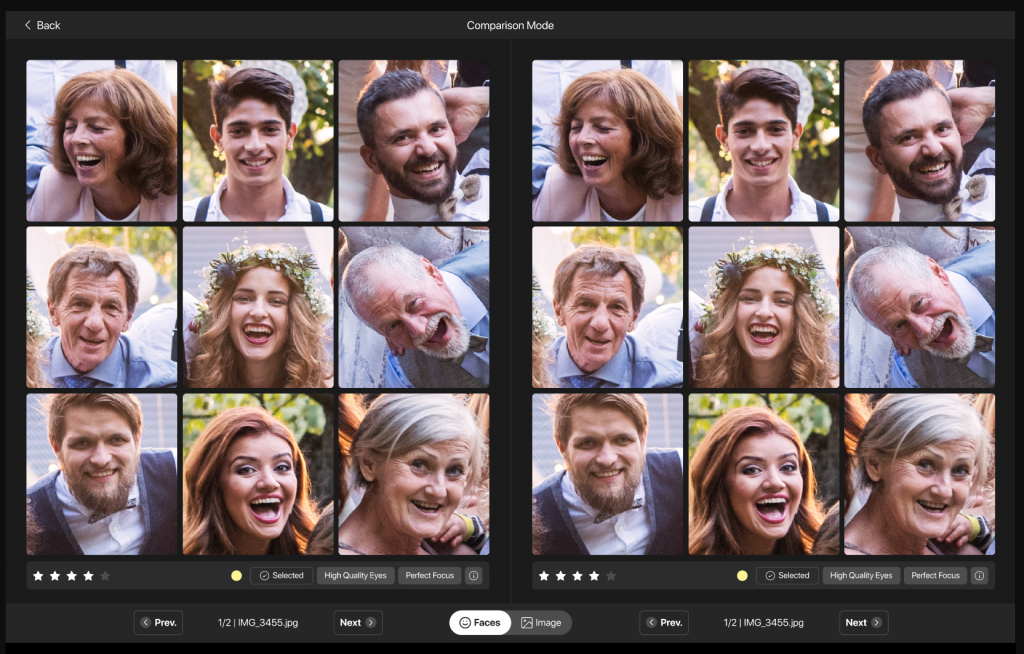 FilterPixel App Comparison Mode
FilterPixel App Comparison ModeWhile this AI-driven software shares some similarities with the abovementioned tools, it distinguishes itself in several ways, including:
- AI Efficiency – Leveraging the power of AI for its photo culling process significantly shortens the importing and sorting stages, making it highly beneficial for photographers dealing with large volumes of photos.
- Customizable Criteria – This provides photographers with the opportunity to integrate their unique style and preferences into the software’s core technology, ensuring that the results will still reflect their distinct standards.
- Seamless Integration – With the understanding that photographers typically work with multiple softwares at a time, FilterPixel offers integration with popular editing software such as Adobe Lightroom which enhances the tool’s versatility and ease of use.
- All-in-one Tool – The ability to import, sort, and edit images all in a single platform allows photographers to enhance their workflows, reducing the need to jump from one software to another.
- Ease of Use – FilterPixel is created for all photographers in every level of proficiency. Its user-friendly interface and intuitive controls makes it easy to navigate for both beginners and professional photographers.
Is it worth investing in FilterPixel?
In evaluating photo culling and editing tools, it’s important to consider its cost in parallel to the benefits and features it provides. FilterPixel’s streamlined and efficient culling and advanced editing directly impact the amount of time you save on these tedious tasks, as well as the quality of your post-processed images. These benefits alone lead to more opportunities to widen your client reach, improve your work productivity, and ultimately boost your revenues.
So, if you’re a professional photographer or an avid enthusiast who values your time and the quality of your images, FilterPixel is worth the investment.
Chapter 10 FilterPixel For Business: How It Can Help Boost Your Photography Enterprise
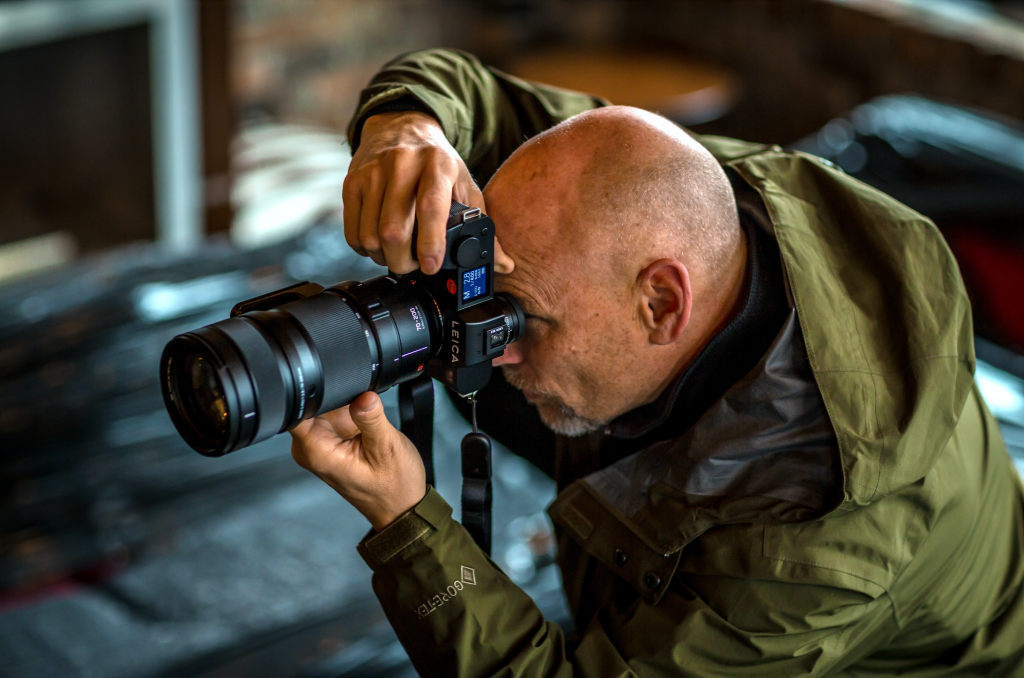 Image by Jordan Bergendahl (Pexels)
Image by Jordan Bergendahl (Pexels)We have established that FilterPixel not only improves your post-production process in its technical aspect, it also plays a vital role in supporting your photography business. In the competitive world of photography, three things remain fundamental to your success: client satisfaction, capacity for growth, and profitability.
Let’s take a look at how you can take advantage of this AI-driven software to accelerate your business growth.
Client Satisfaction, Retention, and Referrals
For any photographer, their client’s feedback is always top priority. FilterPixel contributes to your customers’ satisfaction through:
- Ensuring quick turnaround times as you are able to breeze through importing down to editing
- Providing images with consistent quality, strengthening your reputation among potential clients
- Applying your clients’ specific requirements and preferences by leveraging customizable criteria
Capacity for Business Growth and Expansion
Whether you’re an individual photographer or are part of a larger studio, FilterPixel can support your business’ growth through:
- Providing an avenue to give you more time for business development, marketing, client acquisition, networking, and strategic planning.
- Expanding the services you can offer and at the same time, taking on more clients without compromising the quality of your projects.
- Enhancing your portfolio that will lead to attracting more potential clients and being considered for bigger opportunities.
Reducing Costs and Maximizing Profits
Efficiency does not only relate to time savings, but also optimizing resources to increase profitability. In this aspect, FilterPixel enables you to:
- Decrease labor costs as it reduces the time spent on photo culling and editing
- Allocate resources more effectively to more relevant areas that drive business growth
- Maximize your time and resources, leading to improved return on investment and therefore, higher profits
While these business-related benefits make it easy for most photographers to trust in the capabilities of AI-powered culling and editing softwares, particularly FilterPixel, there are still some hesitations that need to be addressed.
Chapter 11: 6 Common Concerns and Misconceptions About AI-Powered Photo Culling and Editing
 Image by Cottonbro Studio (Pexels)
Image by Cottonbro Studio (Pexels)It’s natural to have concerns or misconceptions in adopting new technologies, especially one that is as transformative as AI-driven image post-production. In this chapter, we’ll address the most common misinterpretations to provide clarity and help you make an informed decision on integrating AI and FilterPixel into your photography workflow.
- Loss of Creative Control – FilterPixel actually empowers your creativity by allowing you to set specific criteria in the culling and editing processes. This ensures that the AI will select images and produce results that align with your creative vision.
- Difficult to Learn – New tools can always be intimidating, especially when it utilizes AI– a fairly new technology that is now being adopted by apps and software. To address this, FilterPixel designed its platform with you in mind, making it easily accessible for photographers who are just starting to transition to using automated tools. Although there will be a slight learning curve, it’s far less steep than mastering complex editing software or manual culling techniques.
- Expensive Investment – Consider the amount of time and resources you can save through FilterPixel, and reallocate them to more impactful, profit-generating aspects of your photography business. Any tool that can be used to add value to your business should be viewed as an investment rather than an expense, as it delivers significant ROI and opens up greater opportunities for growth.
- AI Replaces Human Expertise – You’ve likely heard of this misconception before, especially in talks about AI. However, the goal for fueling this technology is for it to complement human expertise, not eliminate it. While AI can automate the most time-consuming tasks like photo culling, it cannot practice creative judgment, emotional understanding, and artistic intuition that a human photographer brings into every image. Simply put, FilterPixel lets you leverage AI to increase your efficiency and productivity.
- Limited Application and Integration – FilterPixel is geared to adapt to various photography specializations and styles. Whether you’re a portrait photographer, an event or wedding photographer, or a food photographer, the software’s customizable criteria and extensive editing features can easily be tailored to your specific needs.
- Issues on Data Security – In this day and age, data security and privacy are always top of mind. FilterPixel ensures that your images and personal information are kept safe. Nonetheless, it’s important to review the privacy policy and security measures the software provides for your peace of mind.
Essentially, the FilterPixel’s goal is to empower photographers by providing an efficient, customizable, and versatile tool that enhances their workflows and creativity.
Chapter 12 The Future of Photography Workflows with AI
It’s safe to say that AI is making its way into photography, as exemplified by FilterPixel. However, this is just the beginning. As technology continues to evolve, the future holds exciting and potentially game-changing possibilities for photographers. So, what does the future of photography workflows look like with AI?
 Image by Tara Winstead (Pexels)
Image by Tara Winstead (Pexels)AI-Driven Creative Enhancements
AI has already made significant strides in automating repetitive tasks. In the near future, we can expect AI tools to provide more avenues that will enhance any photographer’s creative process. This includes suggesting unique angles, compositions, and lighting setups based on your particular style and niche. AI can then serve as your partner, helping you push the boundaries of your creativity.
Open Collaboration Between Humans and AI
As people become more receptive to AI and the benefits it brings, the synergy between human expertise and AI capabilities will result in highly efficient and innovative photography. AI can assist photographers by instantly offering feedback on image quality, recommendations on framing shots, and tips to optimize camera settings. The key is for photographers to open their minds and continuously learn with their AI software.
Advanced Image Editing with AI
AI’s involvement in photography post-processing will definitely expand as it makes its way into automated image editing. This may include intelligently suggesting enhancements and automating the processes of skin retouching, background adjustments, and style transformations.
Refined Predictive Analytics
The ability of AI to process vast amounts of data can become a key to the growth of the photography industry as a whole. Eventually, it can help make smarter decisions on the subjects, styles, or techniques that will most likely resonate with their audiences and clients. Taking a data-driven approach could empower photographers to create more targeted images.
Increased Focus on Ethical Considerations
As AI becomes more integrated into photography workflows, ethical practices and standards around image manipulation, storage, privacy, and ownership will become even more magnified. Understandably, photographers will need to find the balance between the conveniences of AI and their creative control as well as ethical standards.
The future of photography workflow with AI is incredibly promising. With the right collaboration between human creators and AI features, the industry is headed for more efficient, creative, intelligent, and innovative forms of art.
Conclusion: Elevate Your Photography Workflow with FilterPixel
In the dynamic industry of photography, efficiency and creativity go hand in hand. FilterPixel emerges as a pioneering solution, empowering photographers to excel on both fronts. From the initial import and meticulous organization of your image library, to the selective process of culling, and the transformative editing stages, FilterPixel becomes the driving force that revolutionizes your photography workflow by reducing the culling process by 80% through leveraging the power of artificial intelligence.
Throughout this exploration, we’ve delved into the multifaceted features of FilterPixel and how it can reshape your approach to photography:
- Streamlined Culling: FilterPixel’s AI-driven culling swiftly sifts through vast image volumes, ensuring you efficiently select the finest shots. This not only saves time but also elevates the quality of your final collection.
- Customization: FilterPixel respects your creative control by offering customizable criteria. It empowers you to define the standards that align with your unique style and preferences, allowing the AI to harmonize with your creative vision.
- Editing Capabilities: Beyond culling, FilterPixel provides a comprehensive editing suite. It edits the photos according to your personal style by using expert profiles which are pre-trained AI developed by our team of editing professionals to post-process your photos.
- Versatility: FilterPixel adapts to various photography specializations, catering to portrait, event, landscape, and nature photography, among others. It enhances the workflow of photographers across different niches, ensuring it aligns with your unique creative process.
- Business Benefits: FilterPixel not only enhances your creative process but also imparts a positive impact on your photography business. It fosters client satisfaction, accelerates delivery times, and contributes to business growth, bridging the gap between artistry and commerce.
- AI’s Future: Looking ahead, AI’s role in photography workflows is set to expand. The integration of AI holds the promise of even more exciting possibilities, from AI-driven creative enhancements to advanced image editing and predictive analytics, ushering in a new era of photographic artistry.
Elevating your photography workflow with FilterPixel extends beyond mere time-saving. It’s a transformation that unlocks your creative potential, bolsters your business endeavors, and embraces the opportunities that technology presents.
Embrace the future of photography workflow with FilterPixel and experience the transformation firsthand. Your journey towards a more efficient, creative, and successful photography practice starts here.
